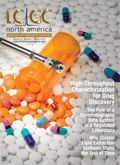Developing HPLC Methods for Biomolecule Analysis
LCGC North America
Gain an invaluable insight into the key methods that are used for biomolecule characterization, process control, and release testing
Biopharmaceuticals offer great hope in treating medical conditions that are currently poorly served by traditional pharmaceuticals.
Figure 1 is a schematic representation of trastuzumab, a monoclonal antibody (mAb) therapeutic agent used in the treatment of HER2 positive metastatic breast cancer and recombinantly produced in Chinese hamster ovarian (CHO) cells. Various regions and features of the protein are outlined in the figure caption and represent some of the important features of the drug that need to be characterized.

Protein Titer (Assay)
During manufacture, the amount of protein in the reaction mixture needs to be determined and this is achieved using columns onto which a protein A or G ligand is immobilized. The monoclonal antibody is retained via conjugation with the Fc region of the mAb while all other species are unretained. The antibody is then released using a low-pH eluent (pH 2.6 typically). This form of separation is known as affinity chromatography.
Charged Variant Analysis
Ion-exchange chromatography is typically used to monitor for enzymatic or chemically induced post-translational modifications (PTMs), which result in charge differences between proteins and can affect efficacy, stability, and toxicity. Monoclonal antibodies are typically net positive (basic) and cation-exchange chromatography is used for characterization and release testing, with the eluent pH adjusted to promote the charged form of both the analyte and stationary phase surface. Elution of the intact protein is typically facilitated using salt or pH gradients, the latter being more amenable to mass spectrometry (MS) detection; small-particle-size columns have been introduced to facilitate rapid, high-efficiency separations.
Size Analysis
SEC is used to separate proteins, fragments, and aggregates according to their hydrodynamic volume, which is a product of analyte mass, folding, and size of the hydration shell, and is used for both characterization and release testing. Silica or polymer stationary phases are used to physically “filter” the species via the pore structure, and the careful selection of the correct pore size range is important. Aggregation and fragmentation of mAbs affect the efficacy and toxicity of the species, and this testing can reveal not only macro changes, such as fragmentation at the hinge region (region 1 in Figure 1), but also subtle differences in linkages between light and heavy chains.
Structural Characterization
Intact and partially fragmented proteins can be analyzed using reversed-phase chromatography with small particles possessing relative large pore diameter (volume) (300 Å being typical) and using shorter ligands such as C4. High-efficiency particles such as the sub-2-µm or core-shell particles combined with short, narrow column geometries are sometimes used when high throughput is necessary. Typically, digestion techniques are used to obtain the Fc and Fab regions (using dithiothreitol) or light and heavy chains (papain) where differences in sequence or modification of the constituent amino acids can be determined.
Digestion using trypsin will produce the constituent peptides that are typically analyzed using high-efficiency C18 or C8 reversed-phase columns of standard pore size and the highly complex chromatograms obtained via MS detection (peptide maps) are used to determine protein sequence.
Glycan Analysis
Region 3 in Figure 1 shows the glycan (sugar) region of the mAb, which determines efficacy of the protein. The sugar subunits of glycans are vitally important and are used to optimize efficacy and to produce “biosimilar or biobetter” molecules that are the generics of the biopharmaceutical world. After enzymatic cleavage and labeling, HILIC chromatography is typically used to separate the various glycoforms, which are highly hydrophilic, and fluorescence or MS detection is used depending on the labeling reagent used.
Amino Acid Analysis
Amino acid analysis is a regulatory requirement and following acid hydrolysis and labeling with OPA or FMOC reagents, separation is achieved using C18 columns with core-shell and sub-2-µm particles becoming increasingly dominant. The stability of the phase at high pH is important, and on-line derivatization followed by fluorescence or UV detection is growing in popularity.
For a full treatment of the topics included here please visit: www.chromacademy.com/HPLC-Techniques-in-Biopharmaceutical-Analysis.html or see reference 1.
References
K. Sandra, I. Vandenheede, and P. Sandra, J. Chromatogr. A1335, 81-103 (2014).

Analyzing Vitamin K1 Levels in Vegetables Eaten by Warfarin Patients Using HPLC UV–vis
April 9th 2025Research conducted by the Universitas Padjadjaran (Sumedang, Indonesia) focused on the measurement of vitamin K1 in various vegetables (specifically lettuce, cabbage, napa cabbage, and spinach) that were ingested by patients using warfarin. High performance liquid chromatography (HPLC) equipped with an ultraviolet detector set at 245 nm was used as the analytical technique.
Removing Double-Stranded RNA Impurities Using Chromatography
April 8th 2025Researchers from Agency for Science, Technology and Research in Singapore recently published a review article exploring how chromatography can be used to remove double-stranded RNA impurities during mRNA therapeutics production.
The Effect of Time and Tide On PFAS Concentrations in Estuaries
April 8th 2025Oliver Jones and Navneet Singh from RMIT University, Melbourne, Australia discuss a recent study they conducted to investigate the relationship between tidal cycles and PFAS concentrations in estuarine systems, and offer practical advice on the sample preparation and LC–MS/MS techniques they used to achieve the best results.
Assessing Safety of Medications During Pregnancy and Breastfeeding with LC–MS/MS
Published: April 8th 2025 | Updated: April 8th 2025Researchers conducted a study on medications used in psychiatry and neurology during the perinatal period, assessing how antiepileptic drugs (AEDs) affect placental functions, including transport mechanisms, nutrient transport, and trophoblast differentiation. Several quantitative methods, such as those for antianxiety and hypnotic drugs, were established to evaluate the safety of pharmacotherapy during breastfeeding using liquid chromatography-tandem mass spectrometry (LC–MS/MS).













